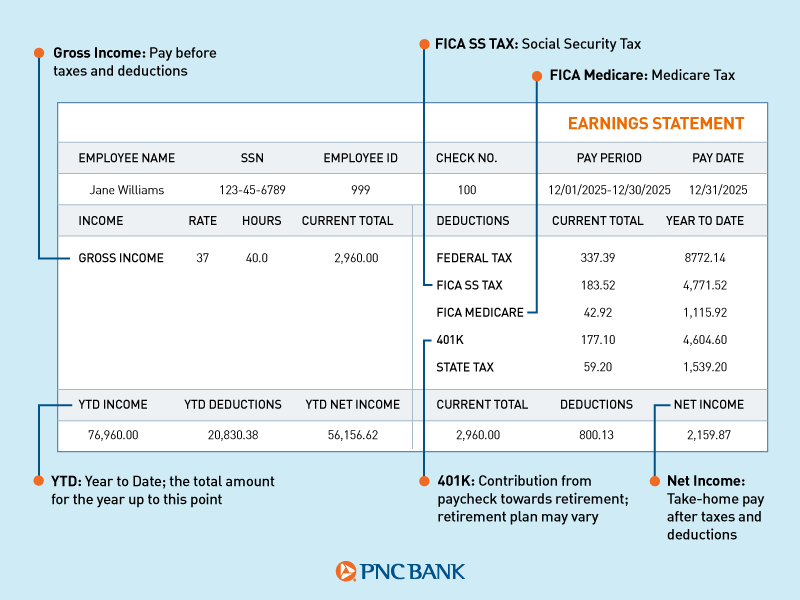
Resumen del artículo
- Un recibo de nómina presenta un desglose de los ingresos, impuestos y deducciones, lo que ayuda a explicar cuál es el destino de su dinero.
- Revisar su recibo de nómina con regularidad asegura que todas las deducciones y retenciones sean correctas.
- El salario bruto representa los ingresos totales antes de deducciones, mientras que el salario neto es la cantidad que en sí recibe.
- Las deducciones comunes incluyen los impuestos federales y estatales, las contribuciones al Seguro Social y Medicare y las primas de seguro.
- Identificar los errores anticipadamente, como las deducciones incorrectas o las horas laboradas reportadas incorrectamente, ayuda a evitar problemas financieros a largo plazo.
¿Alguna vez le ha sorprendido la cantidad de un salario que en realidad no coincidía con lo que esperaba? Desde una bonificación sorpresa hasta las deducciones de impuestos o beneficios, existen muchas variables que pueden afectar su salario neto. Aprender a interpretar un recibo de nómina permite que sea más sencillo comprender exactamente cuál es el destino de ese dinero, lo que le brinda un panorama más claro de sus ingresos y deducciones.
Elementos de un recibo de nómina
Los recibos de nómina se dividen en varias secciones, cada una de las cuales presenta información específica sobre los ingresos y deducciones. Este es un resumen de los elementos principales y cómo estos afectan su salario neto.
Ejemplo de un recibo de nómina

Información del empleado
Esta sección por lo general incluye los datos básicos, como el nombre y la dirección del empleado y, posiblemente, el número de identificación del empleado. Es importante que esta información sea correcta, ya que vincula el salario directamente con la persona. Cualquier discrepancia en esta sección se debe informar al departamento de recursos humanos (RR. HH.) de inmediato, ya que podría dar lugar a problemas con la nómina, dificultades para depositar su salario o complicaciones con las declaraciones de impuestos.
Fechas de período de pago
Las fechas de período de pago indican el inicio y el final del período que se refleja en el recibo de nómina. Los períodos de pago comunes incluyen el semanal, el quincenal y el mensual. Sin embargo, esto varía dependiendo del programa de pago de nómina de la compañía.
Desglose de los ingresos
Esta sección del recibo de nómina indica la cantidad total de ingresos antes de deducciones. En el caso de los empleados que reciben un pago por horas, esto incluye el número de horas laboradas y la tarifa por hora. En el caso de los empleados asalariados, normalmente indica el salario total correspondiente al período de pago.
Si usted ha trabajado horas extras, también estas aparecerán, además de la tarifa a la que se pagaron esas horas adicionales. Las bonificaciones o comisiones normalmente también se reflejan en esta sección, aunque esto puede variar dependiendo de cómo se estructuren en el sistema de nómina de la compañía.
Salario bruto total
El salario bruto total representa la cantidad de ingresos totales durante el período de pago antes de deducciones o impuestos. Esto incluye los sueldos regulares, horas extras, bonificaciones y cualquier ingreso adicional que haya recibido durante el período. El salario bruto es la cantidad de referencia para todos los demás cálculos.
Deducciones e impuestos
Esta sección detalla las cantidades retenidas del salario bruto, que incluyen los impuestos obligatorios y las deducciones opcionales. Las deducciones comunes incluyen:
- Impuesto federal sobre los ingresos.
- Impuestos estatales y locales.
- Seguro Social y Medicare (Ley de Contribución al Seguro Federal, o FICA).
- Primas de seguro.
- Contribuciones para la jubilación.
Revisar las deducciones es fundamental para comprender la cantidad de su salario que se destina a impuestos y beneficios.
Salario neto
El salario neto es la cantidad que le queda una vez que se han restado todos los impuestos y deducciones de su salario bruto. Esta es la cantidad real que recibirá mediante depósito directo en su cuenta o se le entregará en un cheque de salario.
Es importante revisar el salario neto con regularidad para asegurar que todas las deducciones se hayan aplicado correctamente y coincidan con las expectativas. El salario neto también es la cantidad que se utiliza para elaborar un presupuesto doméstico y determinar cuál es la parte de su salario que necesita ahorrar.
Totales en lo que va del año (Year-to-Date, YTD)
Los totales en lo que va del año presentan un resumen acumulativo de todos los ingresos, deducciones e impuestos correspondientes al año presente e incluyen hasta el salario más reciente. Estas cifras resultan útiles para monitorear los ingresos y las obligaciones fiscales durante todo el año.
Cómo descifrar las deducciones de un recibo de nómina
Muchos empleados consideran que la sección de deducciones de su salario es confusa. También es una de las secciones más importantes que debe comprender, ya que las deducciones afectan en gran medida su salario neto. Revisar las deducciones puede ayudarle a identificar con claridad las retenciones que se realizan y por qué se realizan. Estas son algunas de las deducciones más comunes.
Impuestos federales, estatales y locales
El impuesto sobre ingresos federal y el impuesto sobre ingresos estatal son deducciones obligatorias que se toman de cada salario. El impuesto sobre ingresos federal se basa en sus ingresos y en su estado de declaración de impuestos. Esto se determina según los datos que haya proporcionado en el formulario W-4 que completó cuando lo contrataron.
Los impuestos estatales y locales proveen fondos para los servicios y programas del gobierno. Las tasas pueden variar dependiendo de la ciudad y el estado donde usted trabaja, y las deducciones se calculan en función de su nivel de ingresos y categoría impositiva. Algunos estados, como Florida y Texas, no tienen un impuesto sobre ingresos estatal. Muchas zonas no tienen impuestos sobre ingresos locales.
Seguridad Social y Medicare
Las deducciones del Seguro Social y Medicare, que también se conocen como impuestos FICA, son retenciones federales obligatorias. Dichas deducciones se utilizan para financiar el programa del Seguro Social, que proporciona beneficios para los jubilados y personas con discapacidades. También proveen fondos para el programa de Medicare, que ayuda a cubrir los gastos de atención médica de las personas de 65 años en adelante. Actualmente, los empleados pagan el 6.2 % de su salario bruto en contribuciones para el Seguro Social y el 1.45 % en contribuciones para Medicare.[1]
Primas de seguro médico
Si un empleado se inscribe en el plan de seguro médico de su empleador, las primas correspondientes al seguro médico, dental y oftalmológico se deducen de su sueldo bruto. Dichas cantidades varían dependiendo del tipo de plan seleccionado y del nivel de cobertura. En algunos casos, las contribuciones se realizan sobre una base antes de impuestos, lo que puede reducir la cantidad de ingresos gravables. Revisar las deducciones del seguro médico detenidamente ayuda a asegurar que se retenga la cantidad de prima correcta según el nivel de cobertura seleccionado.
Contribuciones para la jubilación
Muchos empleados contribuyen a los ahorros para la jubilación a través de planes patrocinados por el empleador, como los planes 401(k) o 403(b). Dichas contribuciones por lo general se deducen del salario bruto, ya sea sobre una base antes o después de impuestos, dependiendo del tipo de cuenta. Es posible que los empleadores también igualen una parte de estas contribuciones, lo que proporciona un impulso adicional a los ahorros para la jubilación. Comparar las contribuciones para la jubilación contenidas en el recibo de nómina con su opción de deducción puede ayudar a asegurar que sean correctas.
Otras deducciones comunes
Es posible que aparezcan varias otras deducciones en su recibo de nómina. Estos pueden incluir:
- Primas de seguro de vida: si se ha inscrito en la póliza de seguro de vida proporcionada por un empleador, las primas de cobertura por lo general se deducen de su salario.
- Cuentas de gasto flexible (FSA) o cuentas de ahorros para la salud (HSA): si ha optado por participar en una FSA o una HSA mediante deducciones vía nómina, dichos fondos se reservan para gastos de atención médica. A menudo se deducen sobre una base antes de impuestos.
- Cuotas sindicales: es posible que los empleados que pertenecen a sindicatos vean una deducción por concepto de cuota de afiliación.
- Manutención de menores o embargo de salarios: en algunos casos, los pagos solicitados por orden judicial, como la manutención de menores o el embargo de salarios, se deducen directamente del salario y se reflejan en esta sección del recibo de nómina.
Problemas comunes y solución de problemas
Aunque los recibos de nómina generalmente presentan un desglose detallado y preciso de ingresos y deducciones, en ocasiones se pueden producir errores. Los problemas comunes incluyen:
- Retenciones de impuestos incorrectas.
- Falta de pago de horas extras.
- Deducciones de beneficios incorrectas.
- Horas laboradas reportadas incorrectamente.
Estos errores pueden afectar su salario neto final. Por ello es importante que revise detenidamente cada recibo de nómina. Abordar los errores con prontitud puede ayudar a evitar problemas a largo plazo.
Qué debe hacer si identifica errores
Si nota una discrepancia en su recibo de nómina, debe tomar medidas a la brevedad posible. Comience revisando su recibo de nómina detenidamente para confirmar el error. Después, siga los pasos a continuación:
- Revise los recibos de nómina anteriores: comparar el recibo de nómina actual con los anteriores puede ayudarle a determinar si el error es un error por única ocasión o forma parte de un patrón recurrente.
- Comuníquese con RR. HH. o nóminas: póngase en contacto con el departamento de recursos humanos o nóminas para reportar el problema. Proporcione detalles específicos sobre el dato que parece ser incorrecto, como horas faltantes o retenciones de impuestos incorrectas.
- Presente la documentación: si es necesario, reúna cualquier documento de respaldo, como tarjetas de control, contratos laborales o formularios de beneficios que respalden el reclamo. Esto puede ayudar a acelerar la solución.
- Monitoree el seguimiento: si el problema no se resuelve con rapidez, monitoree el seguimiento con RR. HH. o nóminas para asegurar que la corrección se realice en el siguiente ciclo de pago.
Cómo obtener una copia de su recibo de nómina
Los recibos de nómina normalmente se pueden obtener a través del sistema de nómina del empleador. Si no se proporcionan de forma automática con cada salario, a menudo puede acceder a ellos a través de una de las siguientes fuentes:
- Portales de nómina en línea: muchas compañías ofrecen acceso digital a los recibos de nómina a través de un portal de nómina en línea. Los recibos de nómina de períodos de pago anteriores a menudo se guardan en estos sistemas, lo que permite su fácil recuperación.
- Solicitarlo al departamento de RR. HH. o nóminas: si no se cuenta con acceso digital, comuníquese con el departamento de recursos humanos o nóminas y solicite una copia del recibo de nómina ya sea en físico o por correo electrónico. Asegúrese de especificar el período de pago exacto que necesita.
- Aplicaciones de nómina móviles: algunos empleadores ofrecen aplicaciones móviles que están vinculadas a su sistema de nómina, lo que permite que los empleados accedan a sus recibos de nómina y demás información de nómina sobre la marcha.
Utilice sus recibos de nómina para tomar decisiones informadas
Cada sección de un recibo de nómina ofrece perspectivas esenciales sobre los ingresos, impuestos y deducciones. Revisar sus recibos de nómina con regularidad puede ayudarle a gestionar sus finanzas personales, identificar errores anticipadamente y asegurar que su salario neto sea el que esperaba.
Aunque es importante interpretar su recibo de nómina, esto solo es una parte de la administración responsable de su salario. Para aprovechar sus ingresos al máximo, PNC Bank ofrece una variedad de herramientas para ayudarle a ahorrar, gastar y planificar el futuro. Desde establecer depósitos directos hasta desarrollar una estrategia de ahorro o gestionar los gastos diarios, PNC tiene los recursos para ayudarle a mantener el rumbo. Explore nuestras opciones de banca hoy mismo.




